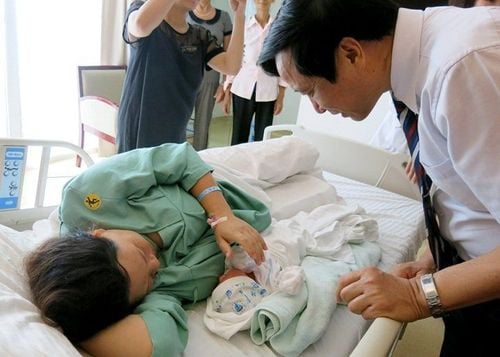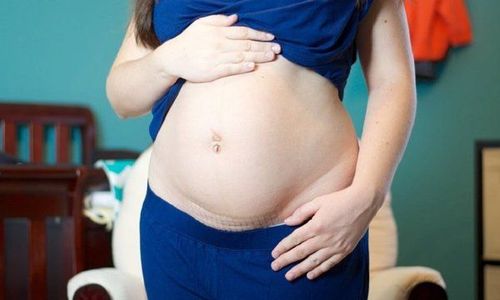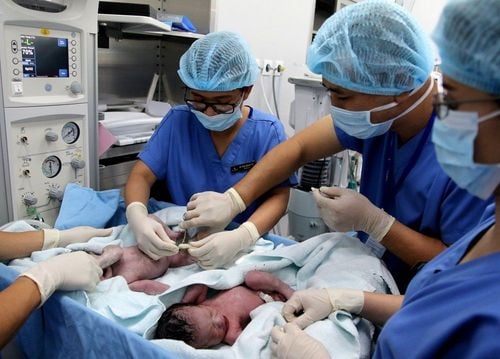This is an automatically translated article.
The article was professionally consulted by Specialist Doctor I Le Thi Phuong - Department of Obstetrics and Gynecology - Vinmec Ha Long International Hospital.A cesarean section is a surgical procedure to remove the fetus, placenta, and amniotic membrane through an incision in the intact uterine wall. During a cesarean section, pregnant women and their unborn babies may face many risks right at birth or after birth. Therefore, specialist doctors recommend that in cases of force majeure who cannot give birth vaginally, they should have a caesarean section.
1. In which case a cesarean delivery is required?
Caesarean section is a common surgery in obstetrics to remove the fetus, placenta, amniotic membrane by an incision through the abdominal wall and uterine wall intact.According to the recommendations of obstetricians and gynecologists, not all mothers necessarily have to give birth by cesarean section, but only in force majeure cases who cannot give birth vaginally should have a caesarean section, because C-section complications can have consequences for both mother and baby. Usually the following cases should be delivered by cesarean section:
Pregnant women have placenta previa: when the placenta is low in the uterus or obstructs the way out of the fetus (placenta previa is one of the causes of bleeding in the uterus). third trimester of pregnancy). Pregnant women with placenta accreta: Abnormal attachment or invasion of part or all of the placenta into the muscular layer of the uterus. In the case of the placenta, the placenta not only adheres to the lining of the uterus as usual, but attaches too deeply to the uterus, can adhere very firmly to the uterine muscle, and even penetrate the uterine muscle layer. Therefore, the placenta with comb teeth cannot peel off naturally or only partially, causing postpartum hemorrhage, therefore, 60% of the placenta comb teeth will be delivered by caesarean section. Pregnant women with placenta previa attached to the placenta: In this case, it can make the consequences worse, contributing to an increase in obstetric complications and maternal mortality. The rate of placenta accreta increased when pregnant women had placenta previa, the rate of cesarean section increased with the number of previous cesarean deliveries. The fetus is too big to pass through the mother's pelvis. Pregnant woman has high blood pressure or a serious illness such as pre-eclampsia The baby's health is at stake and the doctor needs to get the baby out quickly The fetus Abnormal pregnancy position such as: breech, transverse,... Umbilical cord prolapse: when the umbilical cord falls forward to prevent the baby from coming out Pregnant woman has a vaginal infection, which can be transmitted to the baby if the baby comes out out through the vagina.

2. Complications that may occur during cesarean section
2.1. On the mother's side During the cesarean section, pregnant women may face many risks right at birth or after birth. On the mother's side, there can be two types of complications during cesarean section: near and distant complications.Near complications: Infection: possible wound infection, urinary tract infection, pneumonia. Common is surgical site infection; Infection of the amniotic fluid causing peritonitis may lead to a hysterectomy in the postoperative period. Complications due to surgery such as touching adjacent organs (bladder, intestine), right ureteral suture, bladder - uterus/vaginal fistula. Heavy bleeding, Bleeding during or after surgery due to uterine atony; bleeding from a tear in the lower part of the uterus. Intestinal paralysis. Open the incision, herniate the abdominal wall. Internal bleeding. Venous embolism, thrombosis. Maternal mortality: This is considered the most dangerous complication after cesarean section. The cause may be amniotic fluid embolism, bleeding that cannot be stopped or because there is not enough blood when the mother has a rare blood type. Complications due to anesthesia - resuscitation: there may be complications from anesthesia such as aspiration syndrome (in the case of endotracheal anesthesia); hypotension, postoperative headache (in the case of spinal anesthesia), drug reactions (anaphylaxis). Distant complications: Intestinal adhesions, intestinal obstruction. Obstruction of the fallopian tubes causes secondary infertility. Endometriosis at the scar of MLT or scar of abdominal wall surgery. Scars on the body of the mother's uterus can crack in later pregnancies (cracking can be before labor or when it's already in labor). In subsequent pregnancies, the likelihood of having to have a cesarean section increases again and if a vaginal delivery is to be performed, help with delivery by suction or forceps to reduce the risk of old caesarean section cracks on the lower uterine segment... 2.2. On the child's side The baby may be affected by the anesthetic. Injury during surgery. Inhalation of amniotic fluid, especially amniotic fluid containing meconium. Percentage of infants born by cesarean section at risk of severe and life-threatening respiratory failure due to the intervention when the mother is not yet in labor, especially for children undergoing cesarean section at nearly full-term gestation (approx. 37 weeks). The main cause is endothelial disease, which is common in premature babies; alveolar fluid stagnation and the volume of air in the thorax decreased by nearly 50% compared to normal infants; Pulmonary hypertension persisted 5 times higher than normal vaginal neonates. Perinatal mortality (within 28 days after birth) was higher in cesarean section than in vaginal delivery. A cesarean section also increases the risk of stillbirth in the next delivery (it is possible that the uterus is scarred because the previous surgery did not create conditions for the placenta to adhere well, so the blood and nutrient supply is not good.) inadequate fetal nutrition)...
3. How long does it take for your body to recover and get pregnant again?

As for how long it takes for a mother to get pregnant again, doctors recommend waiting at least two to three years to give birth to a second child after a cesarean section, and the best gap is 5 years to avoid complications after cesarean section.
But if because of age or just "missing the plan" to get pregnant, the mother also needs to see a doctor as soon as possible for accurate advice on whether to keep the pregnancy or not and what steps to take. necessary care regime to ensure the safety of mother and fetus.
4. Safe caesarean section at Vinmec using modern anesthetic techniques
Women giving birth by caesarean section at Vinmec are able to relieve pain on the first day after surgery by using lumbar squamous anesthesia, helping the mother to take care of her baby and restore her health better. This is a regional anesthetic technique performed by Vinmec to help block the pain signal before it is transmitted to the spine and to the brain, causing postoperative pain for pregnant women.In addition to the technique of anesthesia of the lumbar squamous muscles under ultrasound guidance, in obstetrics, Vinmec also implements the technique of pudendal neuroanaesthesia to relieve epigastric and epigastric pain, helping pregnant women experience birth in a safe way. the most comfortable, whether it's a vaginal birth or a cesarean section. Thanks to these measures, mothers giving birth at Vinmec can enjoy complete pain relief, quick recovery, early return of bowel movements, early exercise and walking, no chronic pain. Evaluation results The most recent analgesia showed that: ''All pregnant women who give birth by caesarean section do not have to use morphine. Postpartum pain when moving and living is almost no longer recorded''.
Please dial HOTLINE for more information or register for an appointment HERE. Download MyVinmec app to make appointments faster and to manage your bookings easily.














